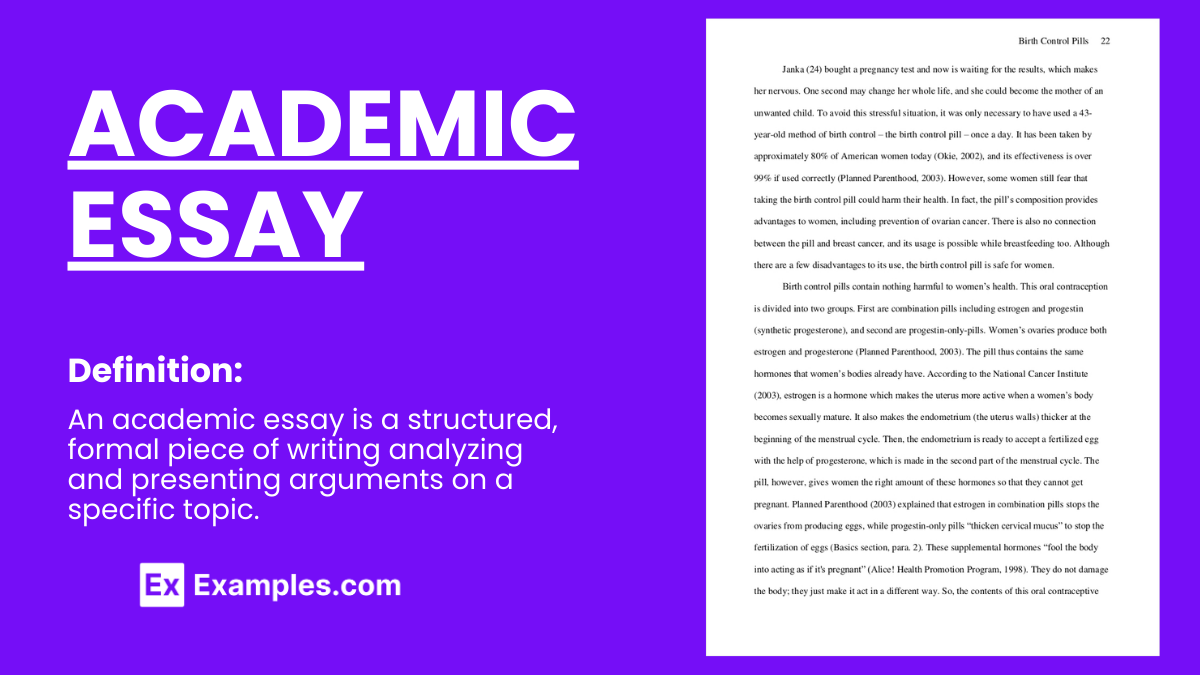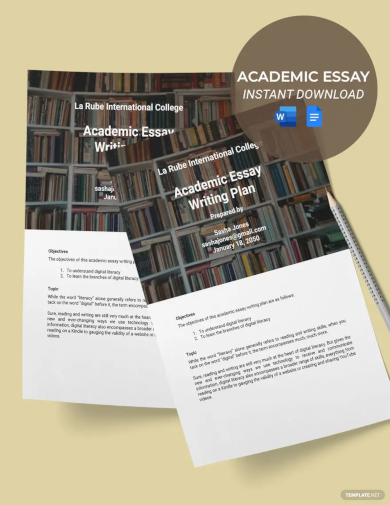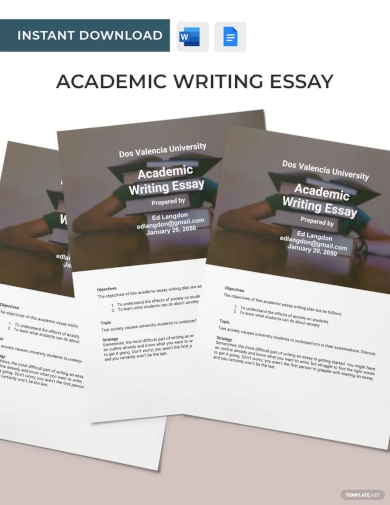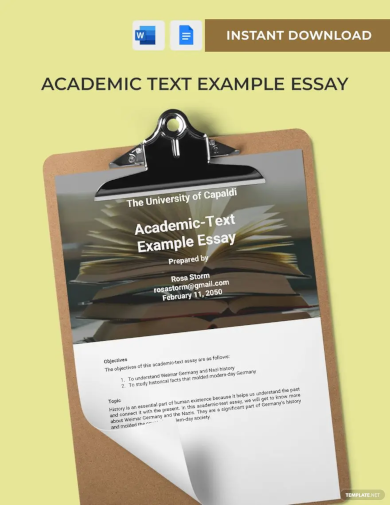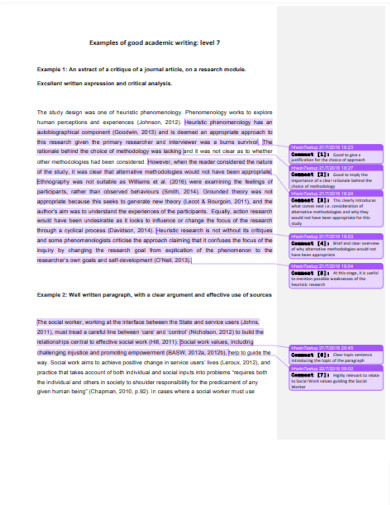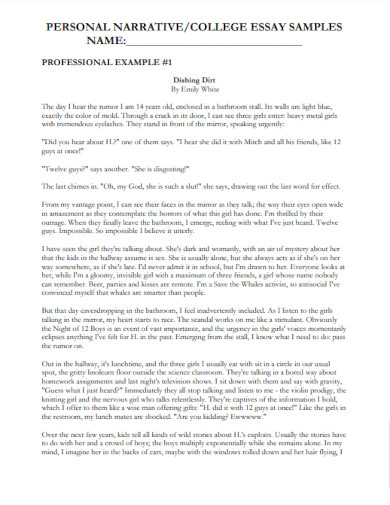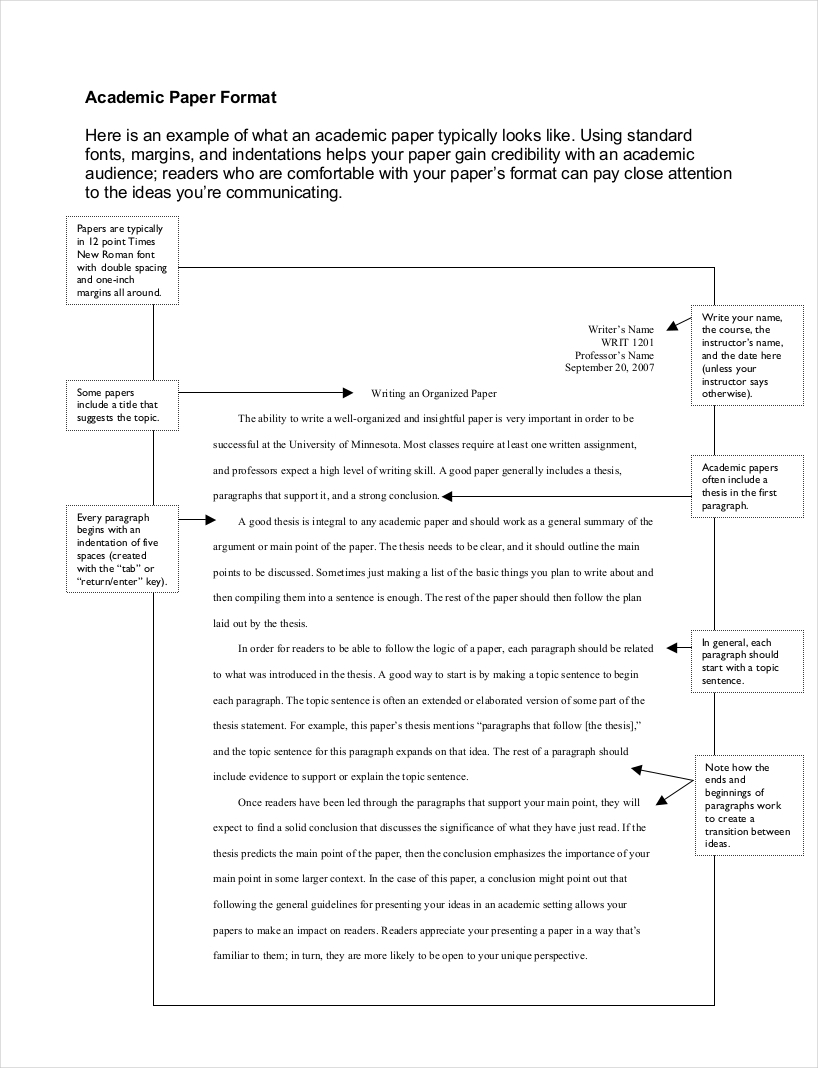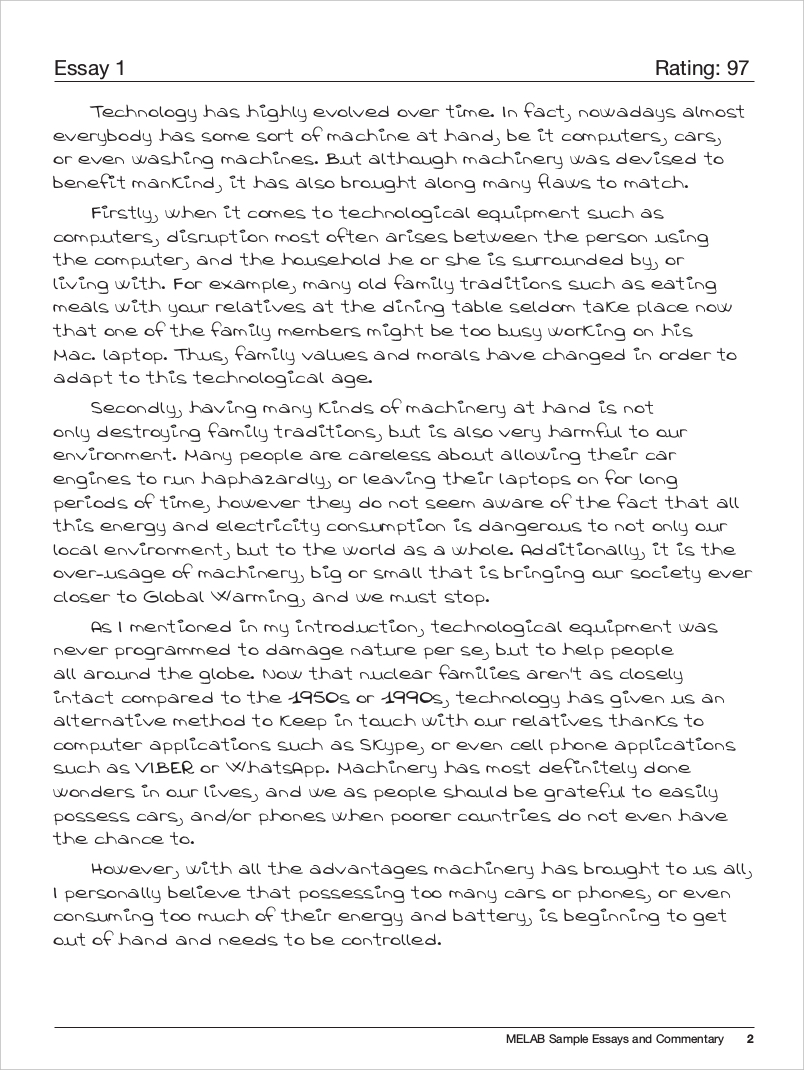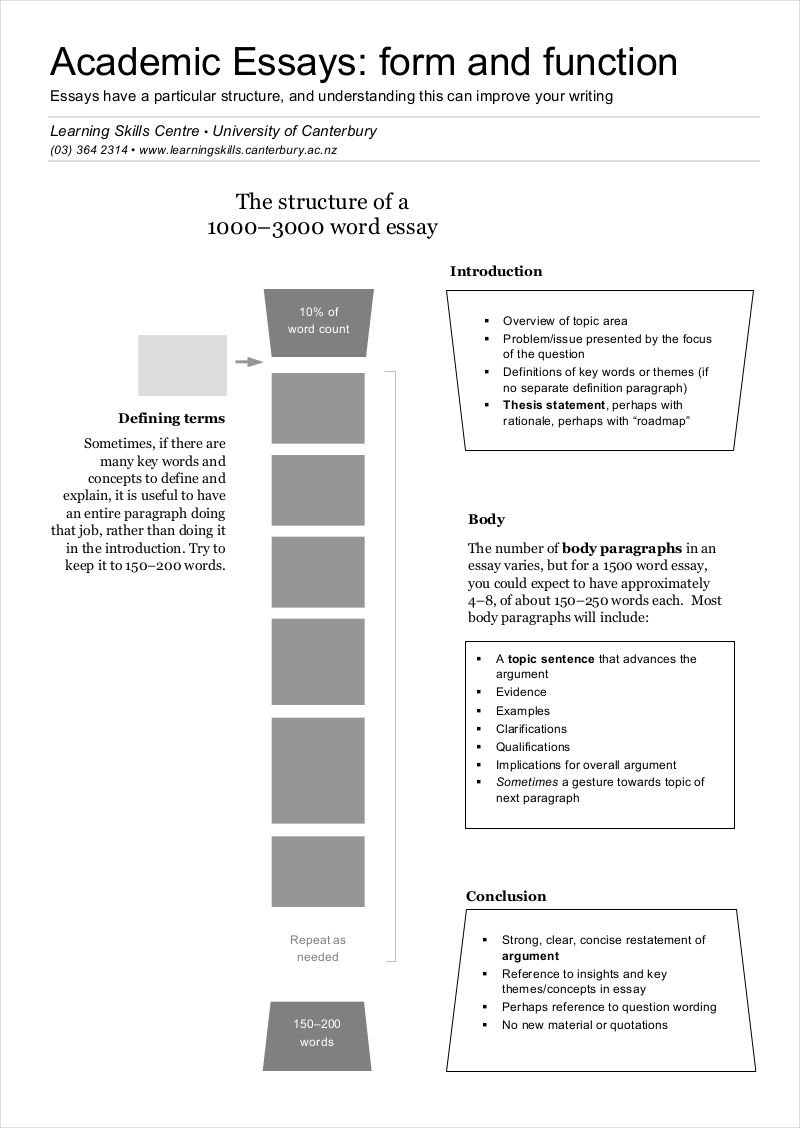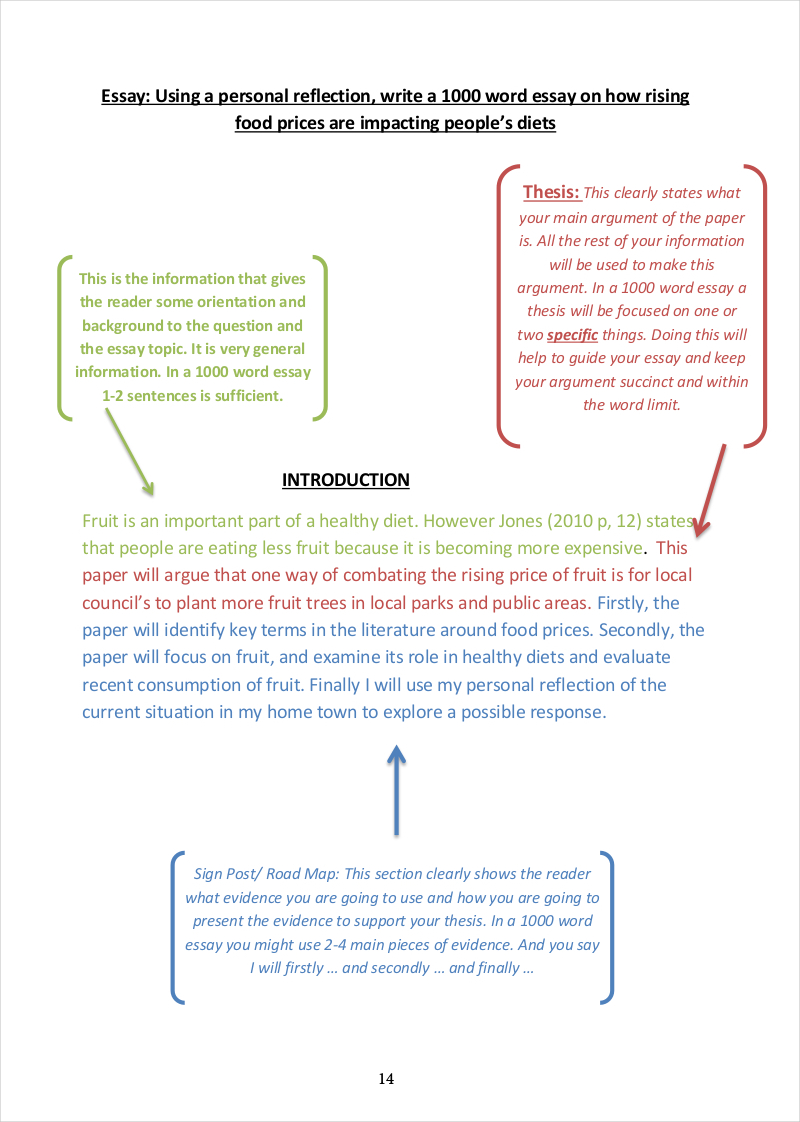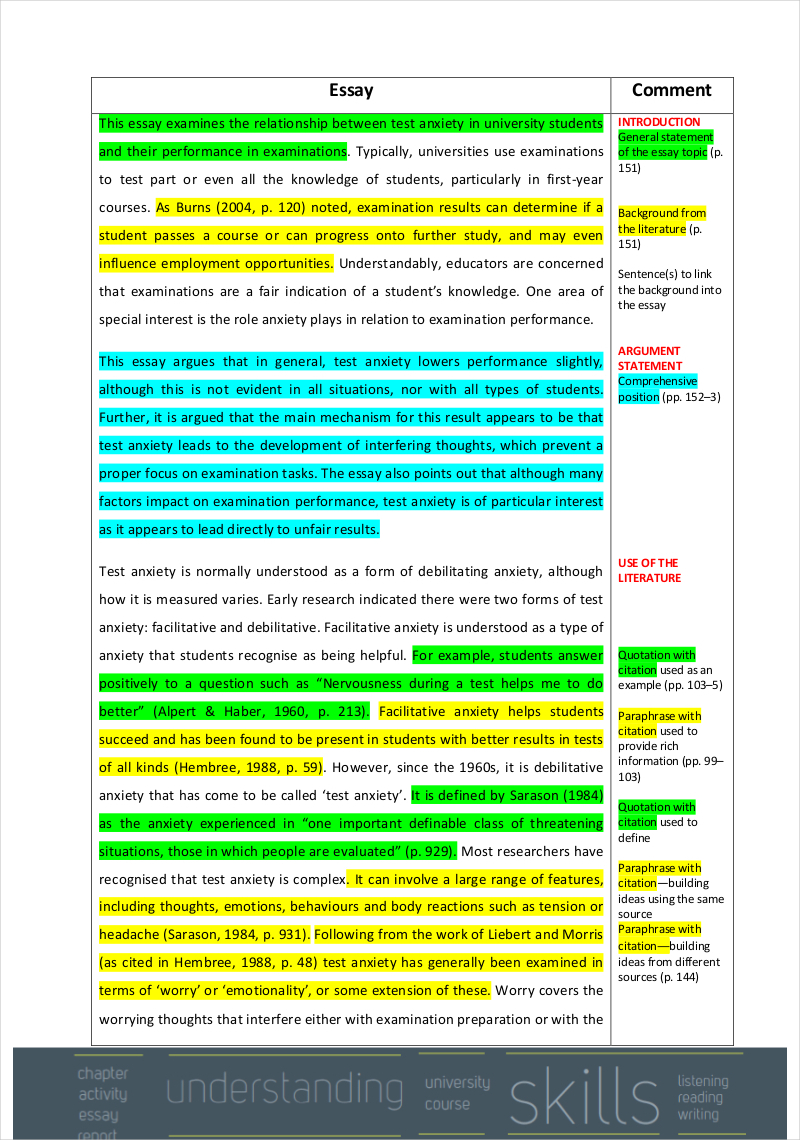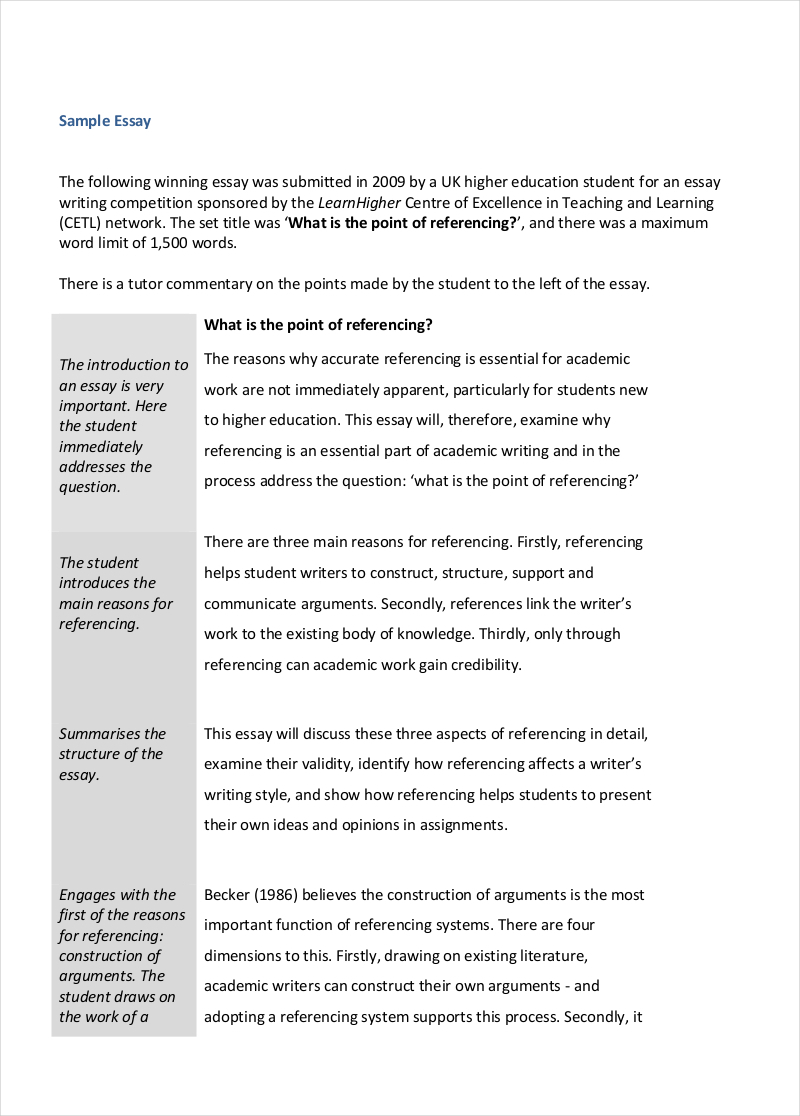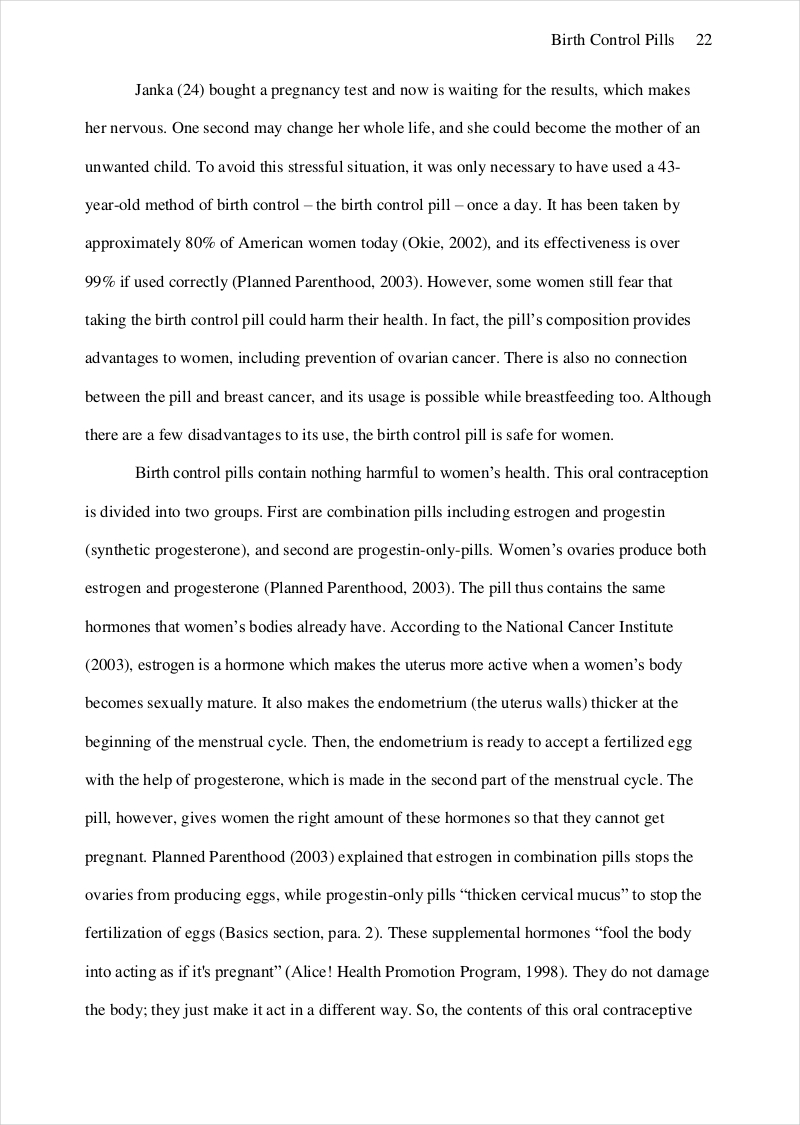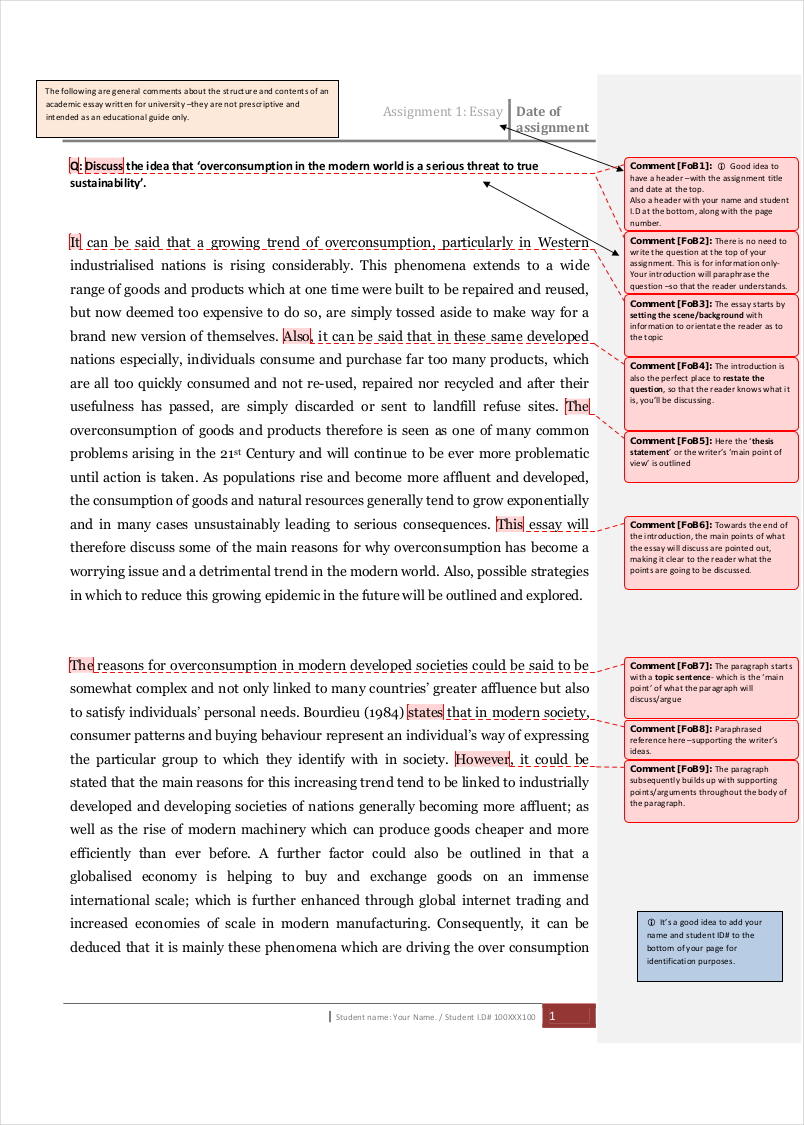36+ Academic Essay Examples to Download
When creating an academic essay, it is very important for you to relay a sensible and clear argument to your target readers. Since academic essays are widely used in the field of education and research, you need to ensure that you do both logical, interesting and informative writing. The items that are commonly seen in an academic essay contain insights, actual occurrences, ideas, and facts.
An academic essay is a structured form of writing that serves the purpose of presenting and supporting a thesis or argument on a specific topic. It is commonly used in educational settings to assess students’ understanding, analytical skills, and ability to research and convey their findings. An academic essay typically follows a clear format, including an introduction with a thesis statement, body paragraphs that provide evidence and analysis to support the thesis, and a conclusion that summarizes the main points and reinforces the essay’s central argument. This type of essay requires critical thinking and a formal tone, with evidence cited from reputable sources to back up claims made within the text.What is Academic Essay?
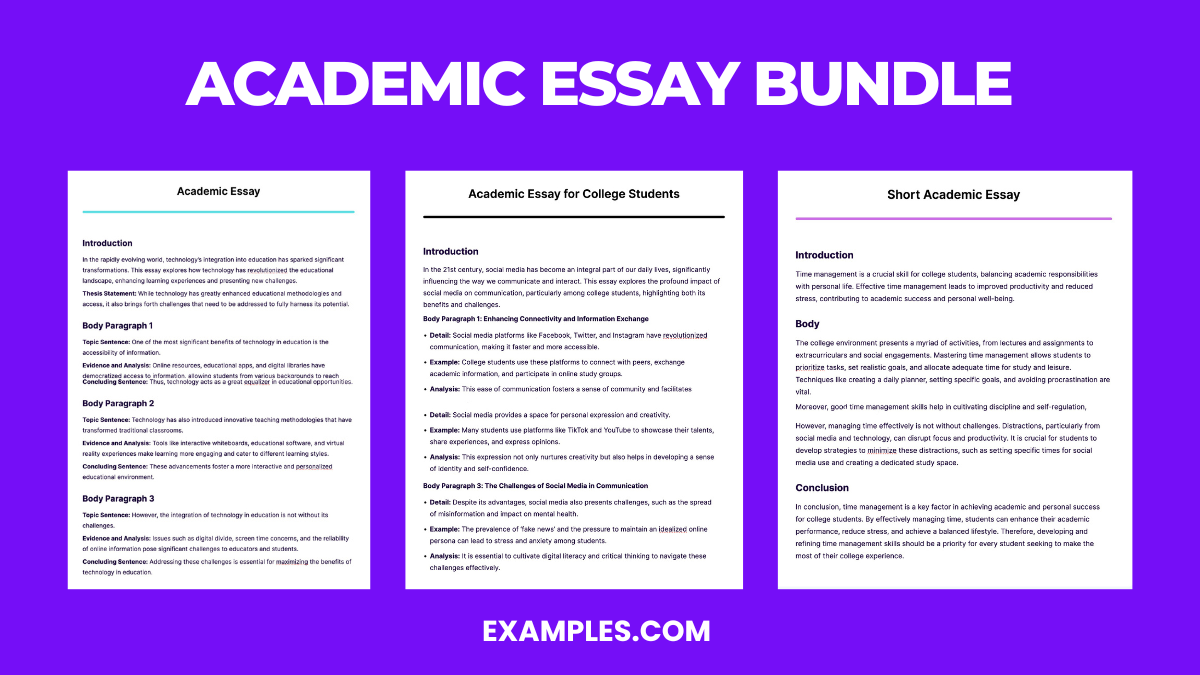
Download Academic Essay Bundle
A lot of students tend to think that an academic essay, just like any other college essay , is something that is too technical or defined. However, you can always write one depending on how you perceive a specific topic of discussion or how you interpret an instance or any other subjects. The samples that we have for you can be a great help if you would like to start writing your academic essay already.
Academic Essay Writing Format/ Outline
1. Title Page (if required)
- Includes the essay’s title, the author’s name, and institutional affiliation.
2. Introduction
- Hook: Opens with a statement to grab the reader’s interest.
- Background Information: Provides context for the topic being discussed.
- Thesis Statement: Presents the main argument or claim of the essay.
3. Body Paragraphs
Each paragraph should focus on a single idea that supports the thesis, structured as follows:
- Topic Sentence: Introduces the main idea of the paragraph.
- Evidence and Analysis: Includes data, quotes, or examples to support the topic sentence, followed by an explanation of how this evidence supports the thesis.
- Transition: Connects to the next paragraph or idea.
4. Conclusion
- Summary of Main Points: Restates the key arguments or findings presented in the body paragraphs.
- Restatement of Thesis: Reinforces the essay’s main argument in light of the evidence presented.
- Closing Thought: Offers a final insight, a call to action, or a suggestion for further research.
Example of Academic Essay Writing
Free Download in Word Free Download in PDFThe Impact of Social Media on Communication
In the digital age, social media has revolutionized the way we communicate, transcending physical boundaries and transforming social interactions. This essay explores the profound impact of social media on communication, examining both its positive advancements and negative implications. While social media platforms like Facebook, Twitter, and Instagram have enhanced our ability to connect with others, they have also led to a decline in face-to-face interactions and a dilution of personal communication skills.
Social media has made it easier than ever to stay connected with friends and family, regardless of geographical distance. A study by Smith and Duggan (2016) found that 75% of internet users utilize social media to maintain relationships with distant family and friends. This widespread use of social media for keeping in touch demonstrates its role as a vital communication tool, bridging the gap between people worldwide. However, the reliance on social media for communication has led to a decrease in the quality of interpersonal interactions. Research by Johnson (2018) indicates a 40% decline in face-to-face conversations among young adults, correlating with increased social media usage. The preference for digital communication over personal interaction suggests a shift in social dynamics, potentially harming relational depth and emotional connections.
Moreover, social media has affected our communication skills, particularly among younger generations. A survey by Lee (2019) revealed that 60% of teachers believe social media use has adversely affected students’ writing and verbal communication skills. The informal language and abbreviations common in social media posts and messages are infiltrating academic and professional communications, underscoring the need for a balanced approach to digital interactions.
Social media has undeniably transformed communication, offering unparalleled connectivity but also presenting significant challenges. While it fosters global connections, its overuse can undermine personal interactions and communication skills. Balancing social media use with face-to-face communication is crucial for maintaining meaningful relationships and effective communication in the 21st century.
What is an example of academic writing?
Title: The Impact of Climate Change on Biodiversity
Introduction: Climate change, driven primarily by human activities such as the burning of fossil fuels and deforestation, has emerged as a critical global concern. This essay aims to explore the multifaceted impacts of climate change on biodiversity. The effects of rising temperatures, altered weather patterns, and habitat destruction are increasingly evident, with far-reaching consequences for ecosystems and species worldwide.
Body Paragraph: One of the most noticeable consequences of climate change is the shifting geographical ranges of numerous species. Warmer temperatures prompt species to migrate to higher altitudes or latitudes, as they seek habitats that align with their thermal preferences. This phenomenon is evident in various ecosystems, including mountain regions, where alpine plants and animals have progressively moved uphill. These migrations, while adaptive, can disrupt established predator-prey relationships and competition for resources. Such shifts can also lead to reduced biodiversity in lower-altitude regions as some species fail to adapt or relocate successfully.
Citations:
- Smith, J., & Johnson, A. (2019). Impacts of Climate Change on Alpine Plant Communities. Environmental Studies Journal, 42(3), 256-270.
- Wilson, P., & Davis, R. (2020). Climate-Induced Shifts in Animal Distributions: Evidence from a Decadal Study. Ecology and Evolution, 10(12), 5963-5972.
Conclusion:
In conclusion, climate change exerts profound effects on biodiversity, manifesting through shifts in species distributions, altered ecological relationships, and habitat loss. As global temperatures continue to rise, addressing these impacts becomes increasingly urgent. Conservation efforts, sustainable practices, and international cooperation are essential in mitigating the repercussions of climate change on the world’s diverse ecosystems and species.
Free Download in Word Free Download in PDFAcademic Essay Topics with Samples to Edit & Download
- Education
- Pollution due to urbanization
- The environmental causes of smoking
- The outcomes of global warming
- Abortion as a controversy
- Causes of obesity in teenagers
- Childhood memories
- Fathers should get equal paternity leave
- Harmful dogs should be euthanized
- How does divorce affects children?
- How does technology affect productivity?
- Importance of preserving threatened species
- Parenting styles and motives
- Political issues in the U.S.
- Romantic relationships
- Should schools abolish homework?
- Violent video games should be banned
- Ways of protecting the environment
Academic Essay Writing Examples & Templates
1. Academic Essay Example
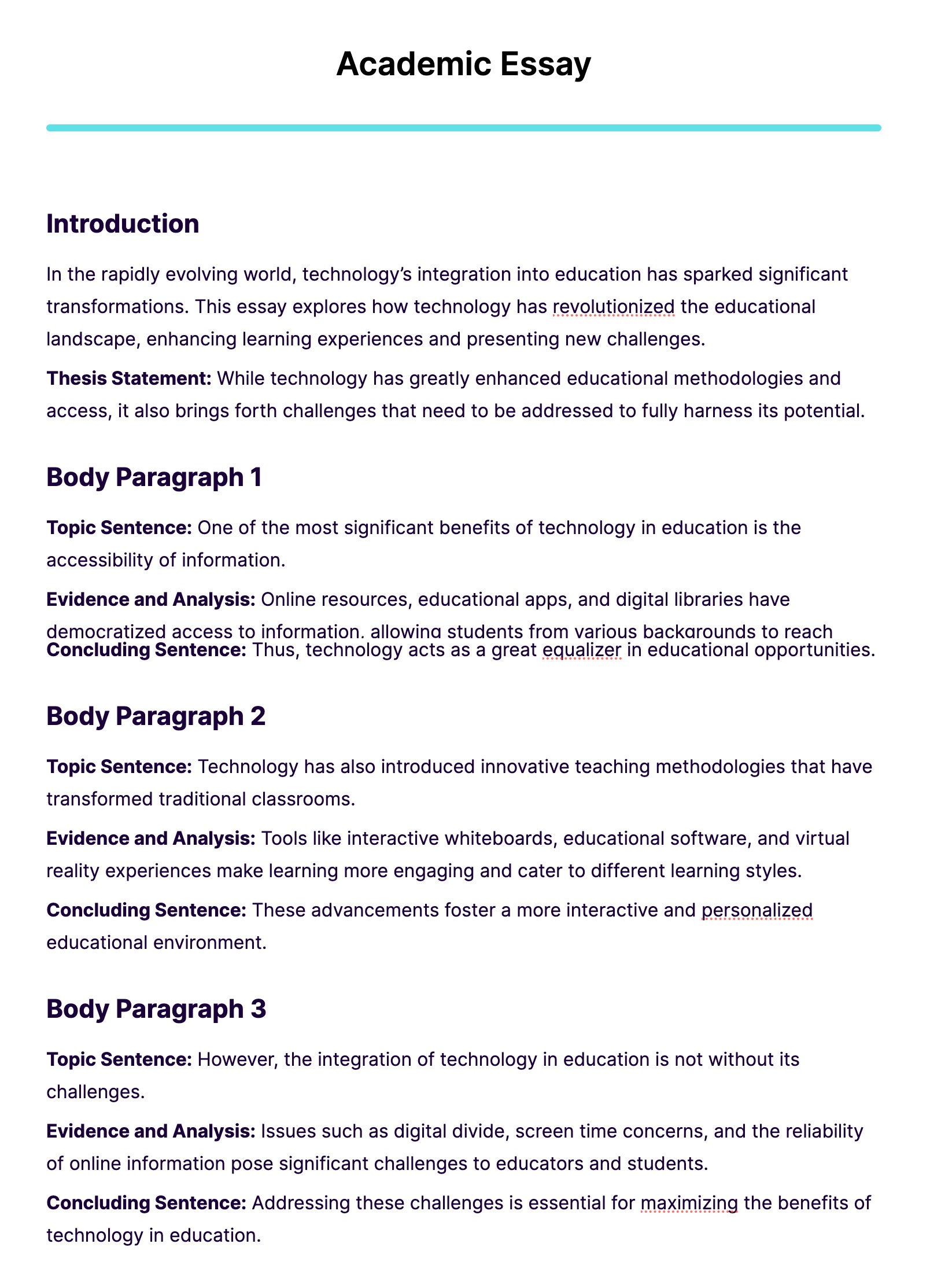
2. Academic Essay for College Students
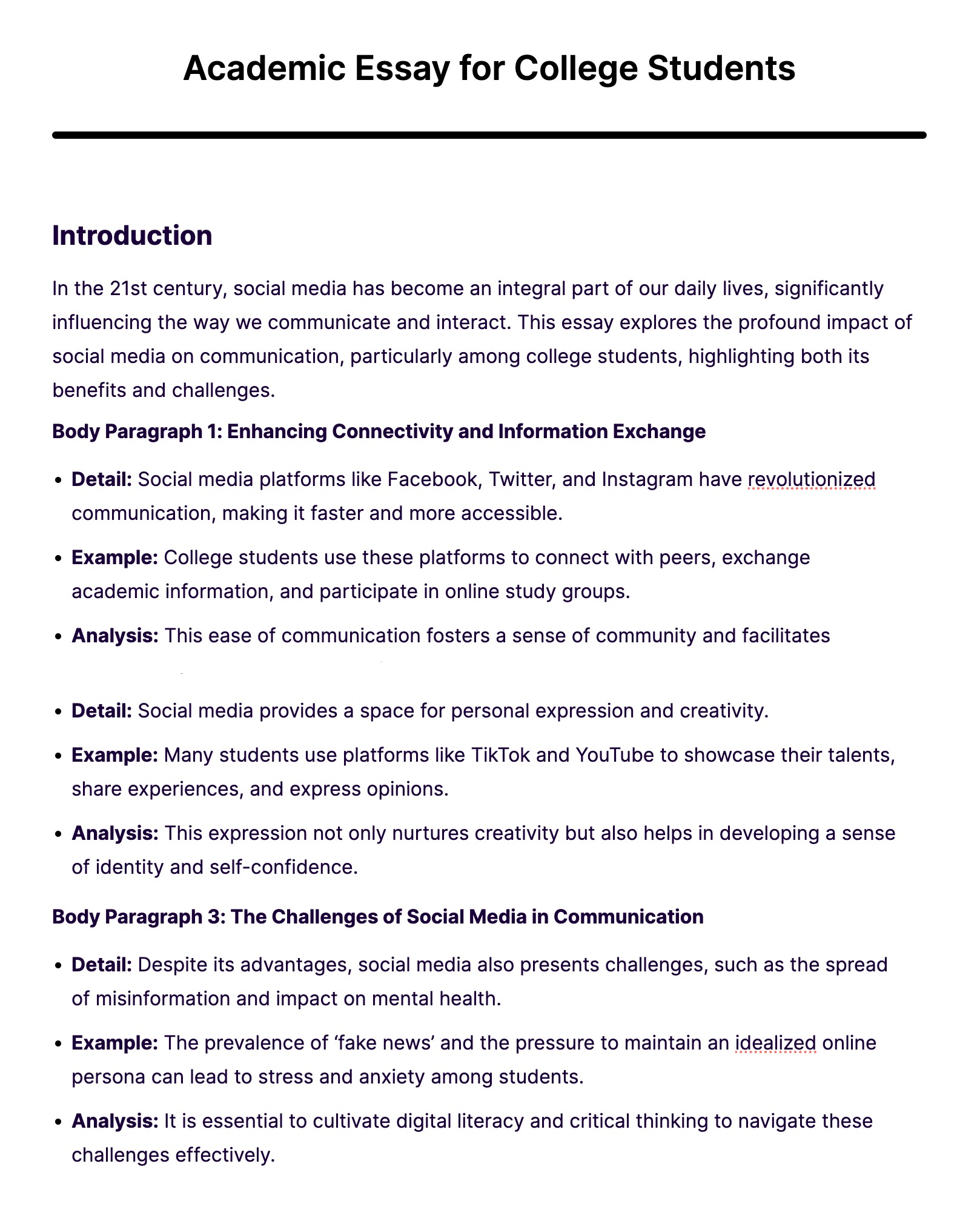
3. Short Academic Essay
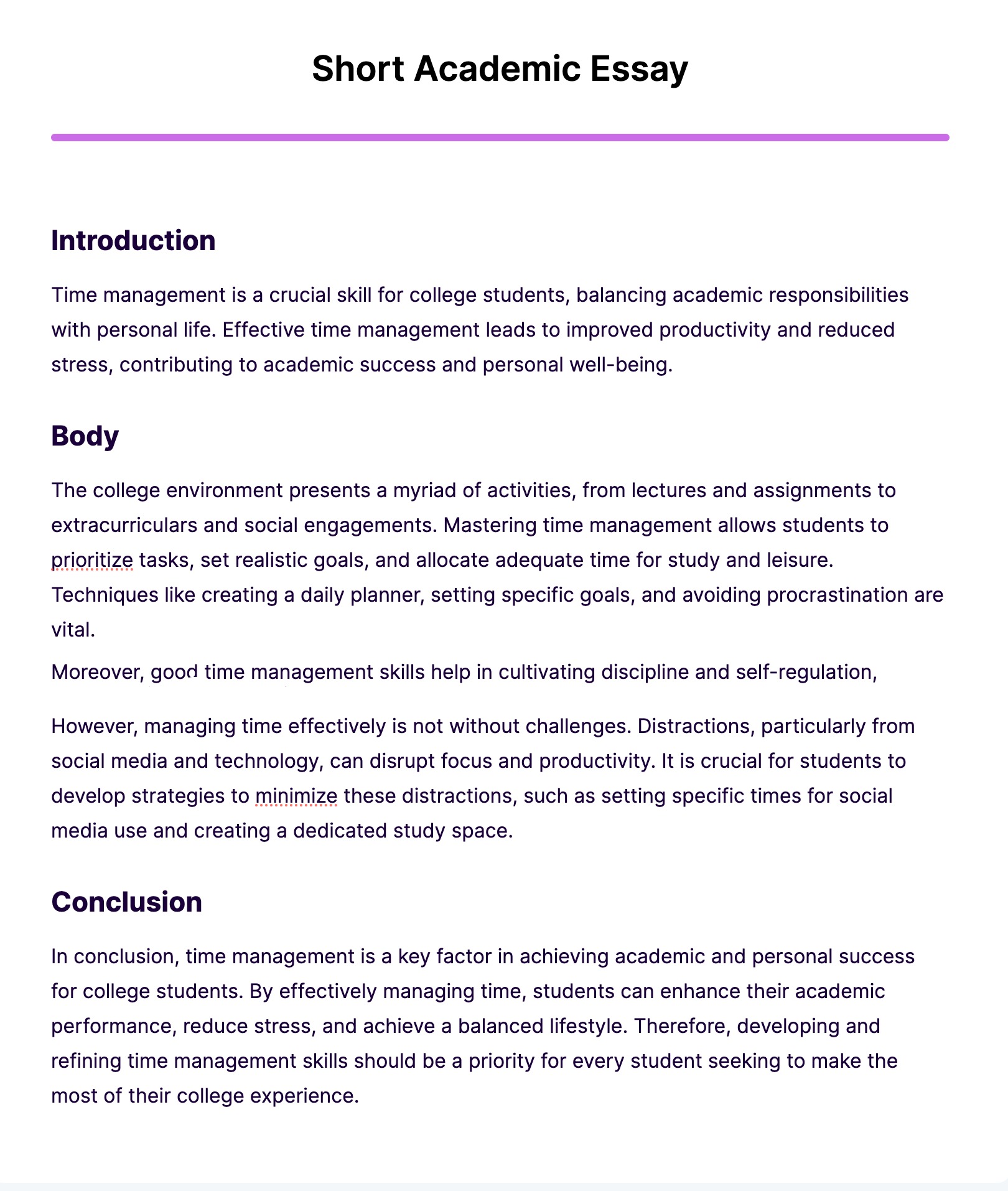
4. Academic Essay Template
5. Academic Writing Essay Template
6. Academic Text Example Essay Template
7. Academic Essay Writing Examples
8. Academic Essay for College Students Examples
9. Narrative Academic Essay Examples
10. Sample Academic Essay Format Example
11. Academic Paper Essay Example
12. Simple Academic Essay Example
13. Academic Essay Sample Structure Example
14. Short Academic Essay Example in PDF
15. Free Printable Academic Essay Sample
16. Sample Academic Essay Example
17. Academic Essay Writing Sample Example
18. Free Academic Essay Sample Guide
19. Sample Academic Essay Outline
Are You Ready and Prepared to Create an Academic Essay?
Different types of academic writing require an individual to have a clear thought process within the entirety of idea development. You have to be focused on what you would like to achieve your final written output so you can incorporate successful guides and processes within the activity. Some of the things that you can talk about in an academic essay include the following:
- Human behavior, characteristics, and emotions
- Community relations
- Natural occurrences
- Language and its effective usages
- Culture and the arts
- Academic researchers
- Relevant cultural phenomenon
- Photography and other artistic undertakings
- Human interactions
- Other subjects that are related to education and academics
Knowing the subject of your article is only one of the initial things that can help you prepare during the writing process. Here are some ways on how you can be ready to write your academic essay:
- You need to have an order of writing that can easily showcase the flow of your thoughts. You must ensure that you can easily connect with your readers or audience so they can respond to the content of your article. Your academic essay should evoke an emotion that is necessary to spark other ideas, opinions and other kinds of responses.
- You need to be aware that academic essays differ depending on the educational or academic discipline where they will be used. There are certain ways that are necessary to be followed in various fields for an academic essay to be deemed effective. With this, always be mindful of the directions or instructions were given to you by the entity who requires you to write an academic essay.
- You do not need to pattern your writing to the works of others. You can be ready even by just knowing your subject and researching about it. The style of writing that you have can give the most difference to how you write and how you present your work. Always keep in mind that your academic essay should be playful – it must not bore your audience.
- You must think of your academic essay as an enterprise by using scholastic writing approaches. The conversation that you can create with your readers must be relevant to what is happening nowadays or for the study that specific student groups need. Being able to give focus on the relativity of your written work can make it easier for readers to understand why your academic essay is important within the academic field.
- You should ensure that your thesis statement is precise, concise, and strong. When you are in the process of developing your academic essay’s thesis, you need to make sure that you are not just basing your write-up on unreliable information. Always refer to evidence, facts, and real data as it can help you strengthen your claims. More so, do not forget to reference your essays when necessary.
Things to Remember When Identifying the Purpose of Your Academic Essay
An academic essay always has to be relevant. It needs to be beneficial to a specific group or to the majority of the academic community. The motive of your essay is very important to be considered as it can identify whether you can be of help to the people who need a particular educational reference. Here are a few things that you need to remember when identifying the purpose of your own academic essay:
- Do not create an academic essay just for the sake of passing it. Your academic essay is more than an assignment or a project. There are some last minute essay writing activities that are done in various fields especially if students think that an academic essay is just a part of their requirements. However, what these students do not know is that an academic essay is a representation of themselves. It showcases the thoughts of the students, what they have learned may it be in class or through self-discovery, and how they are impacted by certain issues and subjects of discussion. This is where the value of a Free Essay and an Informative Essay becomes evident, as both types of essays encourage students to express their understanding and insights on a given topic freely and informatively.
- Be precise with the purpose of your writing. An academic letter is not just a document that can showcase your mastery when it comes to a particular academic subject. It can talk about a specific subject or it can also be a general paper that can provide a lot of information about your experiences and/or insights. This is where the importance of a Self-Introduction Essay comes into play, allowing you to present a personal narrative that reflects your academic journey and achievements. Similarly, an Expository Essay helps in laying out facts and an unbiased analysis of a topic, further enriching the academic discourse. If you will have a precise purpose when writing an academic essay, there is no doubt that your essay will not be pointless.
- Always think of the best case that can help you represent your thoughts. Your style of writing, as well as the entire document’s format and content, can help you realize your ideas. This includes the succinctness and clarity often found in a Short Essay, where the challenge is to convey your thoughts within a limited word count effectively. Similarly, a Scholarship Essay requires you to articulate your achievements and aspirations in a way that resonates with scholarship committees, demonstrating your potential and need for financial support. With this, your point of writing can easily be identified by readers. Being able to present your purpose the best way possible can add up to the success of your academic paper.
Developing an Academic Essay
For you to be able to persuade your readers with the content of your academic essay, there is a need for you to present a structure that can easily identify your claims, arguments, observations, and/or factual presentations. Integrating a Student Essay can demonstrate the personal perspective or learning journey of an individual, making your arguments more relatable. Similarly, incorporating a Travel Essay could enrich your essay by providing unique insights and observations from different cultures or environments. Being clear about how you present your idea is essential for people to see the context of your academic essay.
If you have an organized manner of putting together the concepts of your academic essay, then validating your thesis statement can be more evident. To avoid common essay mistakes and other negative factors that can affect your desired output, here is a basic guide on how you can develop your own academic essay:
- Start by creating a strong thesis statement. Identify your stand and make sure to strictly present evidence that can help you claim its authenticity and validity. Reveal evidence after your thesis statement presentation. Your thesis statement serves as your introduction speech. It lets your readers know the topic of your academic essay and what they can expect from the entire article.
- Establish the context of your essay after your thesis statement. The way that you approach your topic can let readers know whether it is the specific approach that they also need for their undertakings. There are different contexts that can be used within the same subject, so you have to make sure that you will be clear when it comes to identifying the part of the topic that you are going to talk about. This clarity can be achieved through a Descriptive Essay, where vivid descriptions and details about the topic can enlighten and engage the reader. Additionally, understanding the Parts of an Essay is crucial in structuring your thoughts and arguments effectively. Limiting your topic discussion can help you give more focus to what is important for your discussion, ensuring that each part contributes meaningfully to the whole.
- Create the next paragraphs based on the data that can support your thesis statement. The body of your academic essay can be based on your observations, reviews, statements and research outputs. You can present these items separately through the usage of various paragraphs. However, there are instances where it will be better if you can combine or compare to evidence to make your statements more effective.
- Conclude. Your conclusion is as important as your introduction. If you believe that you have created a strong introduction, you have to maintain that until the end of your academic essay. Sum up all the information that you have presented so that people can identify whether your conclusion has lived up to the content of what you have written. Your conclusion can also be used to assess whether your thesis statement has been carried within the entirety of your discussion.
Importance of a Well-Defined Thesis Statement in an Academic Essay
A thesis statement is a paragraph or a set of paragraphs that identifies your stand about your subject. There is a need for this statement to be created as it can affect the entirety of your academic paper. Here are some of the reasons why it is important to develop an effective thesis statement before and while writing your academic paper:
- Your thesis statement is a reflection of your actual idea. This helps you present the point that you would like to make and the message that you actually want to disseminate to your readers. Through a thesis statement, you can organize the evidence that are relevant to your claims based on their relevance to the topic and how you view it as a writer.
- Your thesis statement can guide you within the entirety of your writing processes. Just because you have already done an initial thesis statement does not mean that you are going to fully stick with it until the end of your writing. There are instances where thesis statements are developed or even changes during the creation of an academic essay depending on how the research about the topic has evolved.
- Your thesis statement can allow you to establish originality. Since your academic essay can be based on your research findings and observations, your thesis statement can be your platform to specify what you have come up with. Through a well-defined thesis statement, you can set your output apart from other essay examples that have been written by professionals and other entities in the field of academics.
- Your thesis statement is one of the items that the audience will look at when referencing for credibility and validity. Academic essays need to have a strong initial impact on readers. This statement can help them be focused on a particular standpoint which can enlighten them about your views and opinions, and how these are essential to be considered.
- Your thesis statement can help your readers immerse in your academic essay. The material that you will be coming up with can be reviewed by different people. Depending on the field of education where you are currently in, you need to make sure that your readers can see patterns of evidence presented so they can clearly see how you were able to generate and come up with insights. You have to ensure that the thesis statement that you have created contains the most promising thought so you can get the trust or even the acceptance of your readers about your academic essay’s subject.
Guidelines in Writing an Academic Essay
The course materials that you need to talk about within an academic essay can reflect your level of understanding about the subject. Simply put, an academic essay can be an evidence of the depth of your research procedures and all the other activities that you have executed so that you can support the content of your written output. Listed below are some of the guidelines that can be useful to your academic essay writing processes.
- Always analyze your essay prompt or the question that you need to answer or explain. You have to know whether you are tasked to argue, analyze, or discuss the topic. There will be times where you also need to compare the items present in your subject or explain the underlying factors that can affect your topic.
- Make sure that you will research about what you will write about. Your academic essay can only be fully-maximized if you can present facts. Primary research may be a helpful bit a more precise review of your research topic can help you gather more information that can be helpful in the development of your content. Always assess your sources of information so you can ensure that they are credible.
- Create a draft so that you will have a guide when writing your academic essay. If you will be organized when writing your academic essay, you can create an output that is well-curated and comprehensive. With this, your academic essay can provide more impact to your readers. This can also help you gather your thoughts first and identify how you can put them all together in the most cohesive and efficient way possible.
If you still do not feel confident in writing your own academic essay from scratch, then you can refer to templates and samples which you can download online. Doing this will allow you to be more familiar with the common content and basic formats that are usually seen in an academic essay. When using a template as a guide, always make sure that it is applicable to the study that you are practicing or the academic field or discipline where you will use your academic essay.
As a student, there will always be an instance where we will be required to write an academic essay. If you want to create an academic essay that is both outstanding and relevant, always put the items that we have discussed above in mind.
Setting the Stage for Essay Writing Success
- Understand the Assignment: Carefully read and comprehend the essay prompt or assignment to grasp its requirements and objectives.
- Topic Selection: Choose a relevant and interesting topic that aligns with the assignment.
- Research: Gather credible sources and information related to your topic. Take thorough notes and document your sources.
- Thesis Statement: Develop a strong, clear, and concise thesis statement that presents the main argument of your essay.
- Outline: Create an outline that organizes your essay into sections, including the introduction, body paragraphs, and conclusion. Each section should have a clear purpose.
- Writing Draft: Begin writing your essay, keeping the introduction engaging, and ensuring each body paragraph addresses a single point or idea supported by evidence.
- Citations: Properly cite sources as you write, following a recognized citation style (e.g., APA, MLA).
- Edit and Revise: Review and revise your draft, focusing on grammar, clarity, coherence, and organization.
- Proofread: Carefully proofread your essay for errors in spelling, punctuation, and sentence structure.
- Final Review: Double-check that your essay fulfills the assignment requirements, including formatting, citations, and references.
How do you write an academic essay?
- Understand the Assignment: Read the essay prompt or assignment thoroughly to grasp its requirements and objectives.
- Research: Gather relevant sources and information from books, articles, and credible online sources.
- Plan and Outline: Create an outline with an introduction, body paragraphs, and a conclusion. Each section should have a clear purpose.
- Thesis Statement: Develop a strong thesis statement that presents the main argument of your essay.
- Introduction: Start with a compelling hook, provide background information, and present your thesis statement.
- Body Paragraphs: Each paragraph should focus on a single point or idea, supported by evidence or examples. Use topic sentences to introduce the main idea of each paragraph.
- Citations: Cite sources properly using a recognized citation style (e.g., APA, MLA, Chicago).
- Analysis and Critical Thinking: Analyze and evaluate the evidence or arguments presented, and make connections between them.
- Transition Sentences: Use transition words and phrases to connect ideas between paragraphs.
- Conclusion: Summarize the main points, restate the thesis, and provide a thoughtful conclusion that leaves a lasting impression.
Academic Essay Characteristics
Academic essays are distinguished by several key characteristics that set them apart from other types of writing. These features ensure that essays meet the rigorous standards of academic discourse and contribute effectively to scholarly conversations. Here are the primary characteristics of academic essays:
- Clear Purpose: An academic essay is written with a clear purpose, often to argue a point, present an analysis, or discuss a research finding. The purpose guides the structure and content of the essay.
- Structured Format: It follows a structured format with an introduction, body paragraphs, and a conclusion. This organization helps present arguments and evidence in a coherent and logical manner.
- Thesis Statement: A distinctive feature is the thesis statement, a concise summary of the main argument or claim, usually found at the end of the introduction. It sets the direction for the entire essay.
- Critical Analysis: Academic essays involve critical analysis of ideas, texts, or situations. Writers assess evidence, debate viewpoints, and use logic to develop their arguments.
- Evidence-Based Arguments: Claims made in academic essays are supported by evidence from credible sources. This includes data, statistics, research findings, and quotations from experts.
- Formal Tone and Style: The writing adopts a formal tone and style, avoiding colloquial language, personal anecdotes (unless relevant), and slang. It maintains an objective and professional voice.
Types of Academic Writing
Academic writing encompasses a variety of types, each serving a specific purpose and adhering to a particular format. Here are some of the main types of academic writing:
- Descriptive Writing: This type focuses on describing a character, event, or situation in detail. It’s often used in reports or descriptive essays, where the goal is to provide a clear picture of the subject to the reader.
- Analytical Writing: Analytical writing breaks down complex information into smaller components for better understanding. It involves comparing and contrasting, classifying, and analyzing causes and effects. This type is common in research papers and literature reviews.
- Persuasive Writing: Persuasive writing aims to convince the reader of the writer’s viewpoint or argument. It is characterized by a strong thesis statement, clear evidence, and logical reasoning to persuade the reader. Opinion pieces, argumentative essays, and proposals often employ persuasive writing.
- Expository Writing: Expository writing is used to explain or inform the reader about a specific topic in a clear, concise, and logical manner. It focuses on presenting facts, statistics, and examples without the writer’s personal opinions. This type includes most essays, many types of reports, and certain types of research papers.
- Reflective Writing: This type involves the writer reflecting on their personal experiences, thoughts, or feelings regarding a particular subject or experience. Reflective writing is subjective and is often used in journals, blogs, and reflection essays in educational settings.
- Critical Writing: Critical writing evaluates and critiques the work of others, such as books, articles, or artworks. It involves assessing the strengths and weaknesses of arguments, evidence, and methodologies. Literature reviews, critique essays, and certain types of research papers often require critical writing.
- Narrative Writing: Although less common in strict academic settings, narrative writing is used in certain disciplines to tell stories or describe events chronologically. Personal statements and some types of qualitative research may employ narrative writing to convey experiences and observations.
- Report Writing: Reports convey information from a writer to a reader, focusing on facts and evidence. They are structured and include sections like an introduction, methodology, findings, and conclusions. Lab reports, business reports, and technical reports are examples of this type.
Academic Writing Principles
Academic writing is governed by a set of core principles designed to ensure clarity, precision, and rigor in scholarly communication. Understanding and adhering to these principles is essential for effective academic writing. Here are the key principles:
- Clarity: Writing should be clear and understandable, avoiding unnecessary jargon and complexity to ensure that the reader can easily follow the argument or narrative.
- Coherence: The text should be logically organized, with a clear structure that guides the reader through the argument or discussion. Each part of the writing should connect to the others in a meaningful way.
- Conciseness: Academic writing should be concise, conveying ideas in as few words as necessary. This does not mean oversimplifying, but rather avoiding redundancy and verbosity.
- Objectivity: Writers should strive for objectivity, presenting information and arguments based on evidence rather than personal opinions or biases. This includes acknowledging counterarguments and limitations.
- Precision: Precision involves using the exact words to convey your meaning and being specific about your claims, evidence, and references. This also means accurately citing sources and providing specific data when necessary.
- Evidence-Based Argumentation: Arguments should be supported with appropriate evidence, such as data, examples, and citations from authoritative sources. This principle underscores the importance of research and verification in academic writing.
- Formality: The tone of academic writing is formal, which means avoiding colloquial language, contractions, slang, and humor. Formality also involves using the passive voice where appropriate and avoiding personal pronouns when making general arguments.
- Citation and Referencing: Proper citation and referencing of sources are fundamental to academic writing. This practice not only gives credit to original authors but also allows readers to verify sources and understand the basis of the evidence presented.
- Originality and Plagiarism Avoidance: Academic writing must be original and free from plagiarism. This means that writers should produce their own work based on their research and ideas and appropriately cite any sources they use.
- Critical Thinking: Effective academic writing reflects critical thinking, challenging assumptions, evaluating evidence, and synthesizing ideas from various sources to offer new insights or perspectives on a topic.
How do you start an academic essay sample?
Begin an academic essay sample with a captivating hook, provide context on the topic, and conclude the introduction with a clear and concise thesis statement that outlines your main argument.
What is the opening line of an academic essay?
The opening line of an academic essay should engage the reader’s interest, introduce the topic, and provide a sense of the essay’s focus and importance.
What not to write in an academic essay?
In an academic essay, avoid personal opinions, emotional language, unsubstantiated claims, informal language, and plagiarism. Focus on evidence-based arguments and adhere to academic standards and conventions.
How do you write an academic essay quickly?
To write an academic essay quickly, start with a clear thesis, outline main points, research efficiently, focus on key evidence, and minimize editing while maintaining proper citations and structure.


